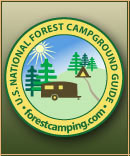Forest Information
The Lewis and Clark National Forest is located in central Montana and is composed of 1,862,314 acres. There are thirty-one developed campgrounds of which fourteen met the selection criteria.
The Lewis and Clark National Forest is located where the golden hills of the Great American prairie meet the magnificent towers of the Rocky Mountains. With this diversity of topography the Lewis and Clark National Forest offers a wide variety of recreational opportunities and camping locations. Camping, hiking, fishing, biking, wildlife viewing, and history - all can be found on the "islands" that make up the Lewis and Clark National Forest.
These "islands" are actually mountain ranges. The Sawtooth Mountains form the Front Range in the western portion of the Lewis and Clark National Forest. Scattered across the eastern portion of the Forest are the Highwood, Snowy, Castle, Little Belt and northern half of the Crazy Mountains. Each group of mountains rises up from the plains like lonely sentinels.
The Lewis and Clark National Forest is named for the leaders of the 1804 Corps of Discovery, Captain Meriwether Lewis and William Clark. It was in Great Falls where the Corps of Discovery spent almost three weeks negotiating a series of Missouri River waterfalls on their way to the Pacific Coast. To illustrate the challenges, courage, and successes of the Corps of Discovery, the Forest Service constructed an Interpretive Center in Great Falls on the banks of the Missouri River near one of the falls. Very informative, well-designed, and with special daily programs, the Lewis and Clark Interpretive Center is a must visit for area visitors.
West of Great Falls is the awesome Rocky Mountain's Front Range. Towering far above the semi-arid plains, the rugged granite face of the Front Range offers spectacular sights, excellent wildlife viewing, and several delightful camping locations. Campgrounds, such as Benchmark, Home Gulch, and Mortimer Gulch, provide car, tent, recreational vehicle (RV) and motorhome camping enthusiasts access to some of the most beautiful and challenging hikes in the Forest. The lure of good Cutthroat and Rainbow trout fishing near these campgrounds attract anglers all summer.
Cave Mountain is a small campground, especially attractive to car and tent campers, hidden in the cracks and folds of the Front Range. To reach the campground one must drive through the Nature Conservancy's Pine Butte Swamp Preserve Area and the town of Choteau, Montana. A brief stop at the Old Trail Museum in Choteau provides a look back into time. This time frame is not only for the last century but far into the past when dinosaurs roamed this area. Ask at the Museum about "Egg Mountain" where the Good Mother dinosaur was found with her nest full of eggs. Tours are provided during the Summer season.
The Snowy Mountain "island" near Lewistown contains a little campground named Crystal Lake.. A rustic campground on the shores of the 100-acre Crystal Lake, this campground has a little bit of everything for a pleasant family camping weekend. Rainbow trout are stocked in the lake and miles of well-maintained trails wander through the mountain. One interesting day hike is to the Ice Cave. About four and half miles one way, the destination is a real cave of ice. Along the way, hikers enjoy a close up view of the Lewis and Clark's flora and fauna. As an alternative to a day of hiking, what about a few hours paddling or floating on Crystal Lake? Or, perhaps spend the day at a campsite watching for wildlife. The Crystal Lake campground offers its campers a complete forest experience.
A pleasant day trip from the little Spring Creek campground is a visit to the Bair Family Museum in Martinsdale. The Museum offers a look into the not so distance past. Featuring antiques collected on trips to Europe by the Bair sisters, priceless bead work of Native American people, and the paintings of such great Western artists as Russell and Sharpe, the Bair Family Museum is a treasure trove to see and explore.
The Lewis and Clark National Forest also offers miles of challenging mountain biking trails throughout the forest. A feature of Lewis and Clark's hiking/mountain biking trails is solitude found on the trail. Between the Jumping Creek and Kings Hill campgrounds eleven different trails can be accessed. With over a hundred miles of trails, the Kings Hill and Judith River Country mountain bike complex has a little of something for everyone. Thain Creek and Logging Creek campgrounds, located nearer Great Falls, also have hiking/mountain biking trails.
Sitting around the campfire after a day of exploring the delights of Lewis and Clark National Forest, it is easy to imagine the accomplishments of those men of the Corps of Discovery. For a moment, just beyond the campfire's dancing shadows, one just might see a member of that party pass by.
ADDRESSES
SUPERVISOR ADDRESS
1220 38th Street North
Great Falls, Montana 59405
406-791-7700
RANGER DISTRICT ADDRESSES
Belt Creek
4324 Hwy. 89 N
Neihart, Montana 59465
406-236-5500
Judith
109 Central Ave.
P.O.B. 484
Stanford, Montana 59479
406-566-2292
Musselshell
809 2nd Street NW
Harlowton, Montana 59036
406-632-4391
Rocky Mountain
1102 Main Ave., NW
Choteau, Montana 59422
406-466-5341
White Sulphur Springs
204 W. Folsom
White Sulphur Springs, Montana 59645
406-547-3361 |
